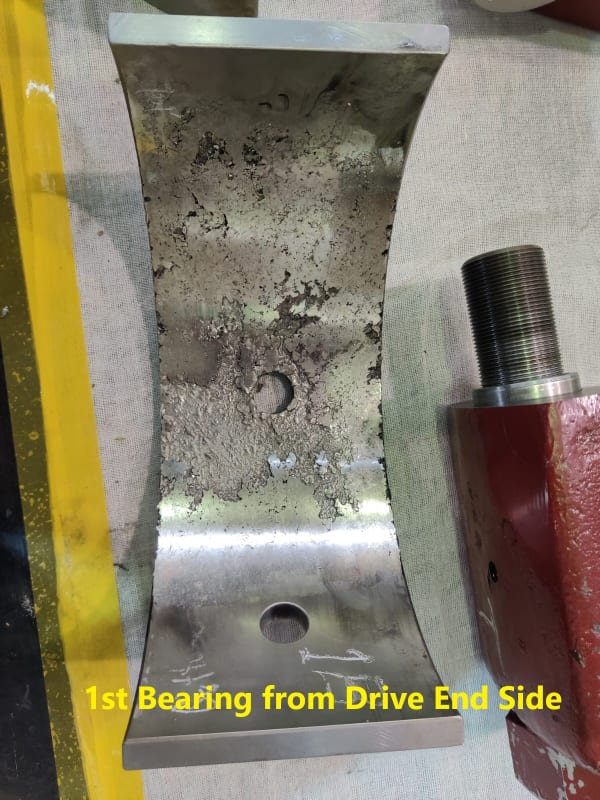-
1
- #1
Greetings fellow engineers,
I am facing a persistent issue with repeated big end bearing failures in a positive displacement (PD) pump, and I am seeking your expert insight to help me diagnose the cause and address this problem effectively.
Problem Description:
We have installed 03 heavy duty PD pump of make PERONI POMPE which make pressure up-to 250 bar, these pumps are installed in parallel arrangement and all remain in service as per process requirement.
We have been facing a recurring pattern of big end bearing failure on one specific pump. Despite thorough maintenance and regular oil changes, the bearings fails after 8-10 months, resulting in unplanned downtime and increased maintenance costs. This issue has become a significant concern for our operations, and we are determined to find a lasting solution.
Details and Observations:
The big end bearings are in two halves and babbit lined. The lubrication mechanism is as such that an auxiliary pump supplies oil to small end bearing at pressure ranging from 10-14 bar and this oil travels through machined ports from small to big end. Following are the re-current observations of failure
•On first bearing, out of five, counting from driving end, Babbit is found chipped off from top half in a spider-web pattern (picture attached).
•Babbit of 4th and 5th big end bearing chipped off at the edges (picture attached).
Maintenance Checks
Following extensive maintenance checks are performed on this pumps, but the problem is persistent. Let me reiterate that same maintenance procedure is followed on other two pumps but this specific unit failing on recurrent basis.
•Casing level checks.
•Thrust line run out.
•Crankshaft end run out.
•Crankshaft web deflection.
•Big end bore face straightness.
•Cross head bore concavity and ovality checks.
•Cross head straightness.
•Connecting rod deflection.
•Pump main bearing bore alignment.
•Main & Big end bearing clearance and ovality.
•Lubrication system port checks for blockage
Expert advise is required on the following :
1) Probable causes of this failure.
2) What steps can be taken to avoid recurrence in future.
Link to pictures
I am facing a persistent issue with repeated big end bearing failures in a positive displacement (PD) pump, and I am seeking your expert insight to help me diagnose the cause and address this problem effectively.
Problem Description:
We have installed 03 heavy duty PD pump of make PERONI POMPE which make pressure up-to 250 bar, these pumps are installed in parallel arrangement and all remain in service as per process requirement.
We have been facing a recurring pattern of big end bearing failure on one specific pump. Despite thorough maintenance and regular oil changes, the bearings fails after 8-10 months, resulting in unplanned downtime and increased maintenance costs. This issue has become a significant concern for our operations, and we are determined to find a lasting solution.
Details and Observations:
The big end bearings are in two halves and babbit lined. The lubrication mechanism is as such that an auxiliary pump supplies oil to small end bearing at pressure ranging from 10-14 bar and this oil travels through machined ports from small to big end. Following are the re-current observations of failure
•On first bearing, out of five, counting from driving end, Babbit is found chipped off from top half in a spider-web pattern (picture attached).
•Babbit of 4th and 5th big end bearing chipped off at the edges (picture attached).
Maintenance Checks
Following extensive maintenance checks are performed on this pumps, but the problem is persistent. Let me reiterate that same maintenance procedure is followed on other two pumps but this specific unit failing on recurrent basis.
•Casing level checks.
•Thrust line run out.
•Crankshaft end run out.
•Crankshaft web deflection.
•Big end bore face straightness.
•Cross head bore concavity and ovality checks.
•Cross head straightness.
•Connecting rod deflection.
•Pump main bearing bore alignment.
•Main & Big end bearing clearance and ovality.
•Lubrication system port checks for blockage
Expert advise is required on the following :
1) Probable causes of this failure.
2) What steps can be taken to avoid recurrence in future.
Link to pictures

